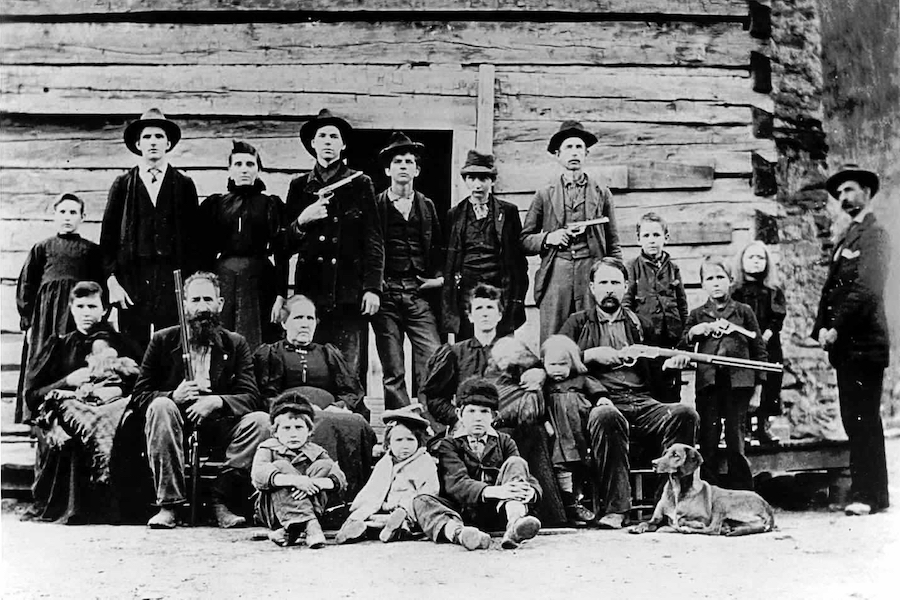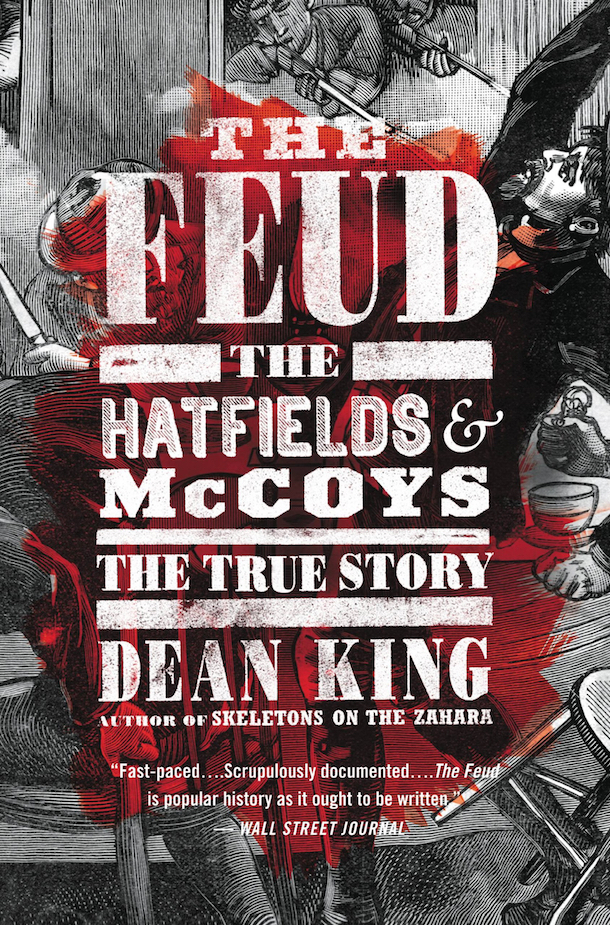
Books
Hatfields, McCoys, and the Legend of the American Frontier Warrior
From the nation’s birth until the 1960s, American culture mythologized frontiersmen and glorified their violence in books, films, and other media. Two cultural narratives dominated. The first, espoused by historian Frederick Jackson Turner, linked the gradual settlement of the frontier with the rise of a democratic, civilized, industrial American society. Turner declared the frontier closed as of 1890 and warned that economic downturn could result.
The second narrative, advocated by statesman and historian Theodore Roosevelt in The Winning of the West, emphasized violence to a greater degree. His ideal frontier was a deadly arena for racial competition and natural selection, where Anglo-Americans tested their spirit, patriotism, and manhood.
Contemporary historian Richard Slotkin called this phenomenon “regeneration through violence” in his eponymous 1973 book. Roosevelt further believed that an Anglo-American’s sustained endurance of the frontier life’s rigors could prepare him for leadership. Those brave enough to win against the environment and the Indian race would lead their frontier communities. Roosevelt lionized frontiersman like Davy Crockett, Daniel Boone, and Kit Carson. He revered Hawkeye, the Indian-savvy warrior protagonist of James Fenimore Cooper’s Leatherstocking Tales.
Roosevelt influenced the powerful successor to his and Cooper’s works in shaping the American frontier mythology: Buffalo Bill’s Wild West show.
William F. “Buffalo Bill” Cody and colleagues first introduced their Wild West show in 1883. For urbanite Americans and Europeans, the show offered a sanitized, sensationalized version of frontier life. Crowds numbering as large as 20,000 gleefully applauded cowboyin’ staples like rope tricks and bulldogging. They watched reenactments of violence like an Indian attack on a stage coach and Custer’s Last Stand. The show toured around the world and performed twice before England’s Queen Victoria.
One show program equated the utility of the rifle with that the school book and the Bible: “[While it is] a trite saying that ‘the pen is mightier than the sword,’ it is equally true that the bullet is the pioneer of civilization, for it has gone hand in hand with the axe that cleared the forest, and with the family Bible and school book. Deadly as has been its mission in one sense, it has been merciful in another; for without the rifle ball we of America would not be to-day in the possession of a free and united country, and mighty in our strength.”
By the time Buffalo Bill’s show closed in 1917, its formula had already been adopted by the nascent film industry. Several decades saw the primacy of conventional Western, frontier tales on screen. Filmmakers often did little more than replay Buffalo Bill’s most popular acts in front of the camera.
By the Vietnam Era, Hollywood actor John Wayne had cornered the market on traditional Westerns. As historian Richard Slotkin explained in Gunfighter Nation (1992), Wayne “had become a kind of folk-hero, his name an idiomatic expression, a metaphoric formula or cliché that instantly invoked a well-recognized set of American heroic virtues.” Vietnam veteran Ron Kovic, author of Born on the Fourth of July (1976), joined the Marine Corps partly due to Wayne.
The 1960s also saw the first strongly revisionist frontier tales onscreen and in print—stories which conveyed violence on the frontier in plain, unheroic terms. Cormac McCarthy’s first novels, The Orchard Keeper (1965) and Outer Dark (1968), depicted a beautiful but unforgiving, arbitrary natural environment.
Italy exported its popular Sergio Leone Westerns to the United States, where they debunked frontier mythology. Leone’s frontiersmen in his Dollars trilogy deal in the darkest comedy, kill for buried treasure, and talk frankly about the emptiness of war. “I’ve never seen so many men wasted so badly,” says Blondie, the protagonist played by Clint Eastwood, as he observes a Civil War battle.
The past two decades have seen this revisionist reaction strengthen. Onscreen, Eastwood’s films like Mystic River (2003), Gran Torino (2008), and Unforgiven (1992) have redacted the glory from frontier and urban killings. “It’s a helluva thing, killing a man. You take away all he’s got, and all he’ll ever have,” says protagonist William Munny in Unforgiven. The Schofield Kid, eager to play tough before Munny, adds, “Well, at least he had it comin’.” Munny says, “Kid, we all got it comin’.”
Two of Cormac McCarthy’s later novels, Blood Meridian (1985) and No Country for Old Men (2005) drove antique cowboy mythology from his narrative terrain. In the latter, Buffalo Bill’s storybook spectacle never appears. Hunters and the hunted populate the desert horizon day and night and neither finds any peace. “This country will kill you in a heartbeat and still people love it,” says Ellis, a retired lawman.
In this context arrives Dean King latest nonfiction book, The Feud: The Hatfields & McCoys: The True Story, a new entry in revisionist frontier history. The book will see paperback release in May 2014. After documenting courage and adventure from Britain to Beijing in his six previous books, King turns homeward, reporting on the legends hatched in the hollows and hideouts of West Virginia, the land of his forebears.
The Feud concerns the twenty-five year conflict between two American families, the Hatfields and the McCoys, living along the banks of the Tug River on the Kentucky-West Virginia border. From approximately 1865 to 1890, the families fight like badgers despite intermarriage. Though far from the American West, they live an unvarnished pioneer existence, lacking telegraphs, rails, and schools. “In an isolated pocket of the southern Appalachian Mountains,” King writes, “two Old World families, suspended in geographic convolutions as ancient as time, in ridges and hollows that seemed to stop clocks…continued the [Civil War’s] bloodshed over matters of passion and honor.” The feud leaves a dozen dead and more wounded.

In style and substance, King upends the mythological conventions established by Turner and Roosevelt, allowing the frontier’s frostbite, snakebite, and solitude.
Contrary to Teddy Roosevelt’s Western ideal, the Hatfield-McCoy feud occurs within the white community, without interference from Indians or any other foreign community. Neither of the families demonstrates heroism. The towering personality of the community, Devil Anse Hatfield, murders without remorse. While other frontiersmen shuffle off their Old World strictures and smile at the unfenced life, the Hatfields and McCoys nurse grudges until killing seems the only recourse.
King anchors his story in realism. The feud’s antagonists defy hillbilly caricature; they pride themselves on their resourcefulness, harvesting wool from nature’s crudest fleeces. The mountaineers use ginseng medicinally, hunt bear, and make mint tea. They grow corn, wheat, and flax on steep inclines. They risk life and limb floating timber downriver. Interestingly, Hatfields meeting in the woods hoot like owls to each other to signal familiarity.
The Feud’s greatest reform is its portrayal of frontier violence—shaded nearly as dark as Cormac McCarthy’s. By denying the feud any heroes, King does history a service. He never polishes the violence. His prose builds drama without sensationalism. Ribs simply snap “like dry sticks.”
Like McCarthy, King reports the Hatfield-McCoy killing spree with clinical precision and black lyricism. At one point, a gang of Hatfields execute three McCoys in the woods after an Election Day dispute ends in the brutal murder of Ellison Hatfield, Devil Anse Hatfield’s brother:
It was a chilly summer night. Stars buckshot the black sky. Several hundred feet upstream from where they had forded the river and about a quarter mile below the mouth of Sulphur Creek, the execution squad reached a depression in the bank, a sink opening onto the river, where rubbish was dumped, including, recently, the carcasses of sheep-killing dogs. They would go no farther.
At a copse of pawpaws, the men hung a lantern to cast some light and to check for snakes, which were said to prefer blackberry bushes and pawpaw trees. They shoved the trio of McCoys to the ground among the fallen tree fruit, now split open and rotting, and bound them to the saplings…They deliberately placed Tolbert with his back toward them, in response to his insolent challenge to look him in the eye. Pharmer, in shock from fear, faced them like a treed raccoon in torchlight. Innocent Bud turned toward his brothers, who had gotten him into this and who could equally do him no good now. The firing squad…got into position…a fusillade ripped through the languid late-summer air…After the burst of fire—fifty shots or more—several more reports rang out. Then, for maybe two minutes, silence.
Humor only shows itself at the gallows—literally. After Cotton Top Mounts rides atop his own coffin to his hanging, he exclaims: “The Hatfields made me do it!”
The greatest potential blunder for feud historians is to force a single rationale for the fighting. Some historians attribute the feud to the theft of a razorback hog in the 1870s. Others point to Asa Harmon McCoy’s death in 1864, allegedly at the hands of a Hatfield, or the Civil War’s legacy in the Tug River Valley. Altina Waller’s influential 1988 book, Feud: Hatfields, McCoys, and Social Change in Appalachia, 1860-1900, ascribes the feud to industrial economic forces.
King wisely defines a feud as something that defies simple rational explanations and that includes emotions, pride, and a sort of family tribalism. He casts a wide net for causes of the feud: “Like a bonfire lit from three different sides, the conflagration grew out of these events—though they occurred over a span of decades—and gained strength from their accumulation.”
By limiting his interpretation of the tragedy, King forces the reader to set aside proximate causation and consider deeper flaws in Western historiography. In his narrative, human frailty and whiskey speak, not the affectations of hero cultists.
Nowhere is King’s revisionism more apparent than in his negative portrayal of Devil Anse Hatfield, the archetypical frontier warrior. In The Feud, a pinprick is enough to injure his pride. U.S. deputy marshal Dan Cunningham calls Devil Anse “no soldier at all,” a “murderer” and “bush-whacker.” Though feud historians like to invoke Romeo and Juliet to describe the Hatfield-McCoy tensions, Devil Anse’s cowardice recalls Shakespeare’s Richard III: “Uncertain way of gain! But I am in/So far in blood that sin will pluck on sin.”
Like Gunfighter Nation and No Country for Old Men, The Feud questions the bullet’s place in civilization. These sage works value truth over showmanship in storytelling—even on a subject as storied as the wild frontier. Their authors never place a gun in a character’s hand without considering the consequences.
“Every step you take is forever,” reads No Country for Old Men. “You can’t make it go away. None of it. You understand what I’m sayin’?”

